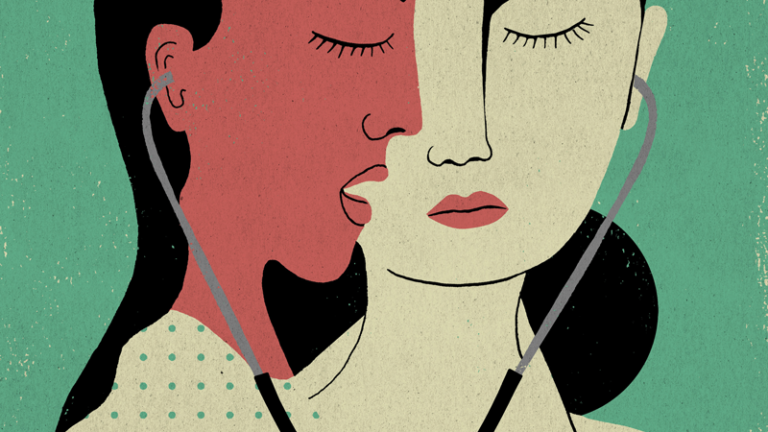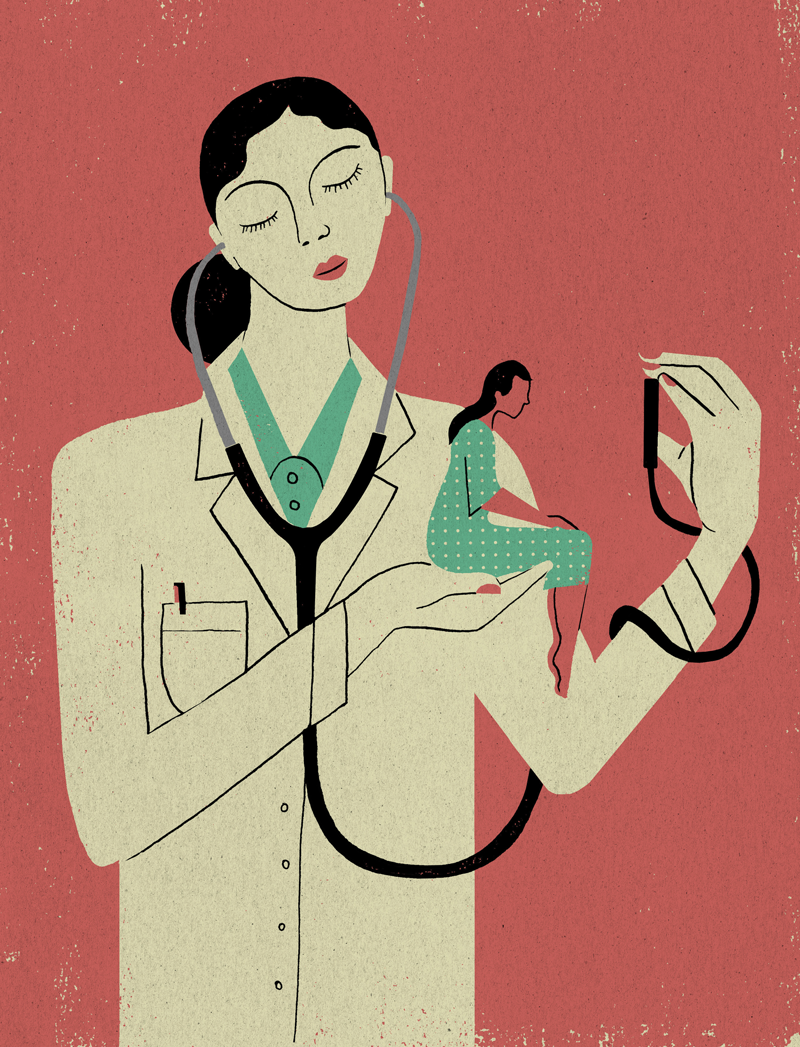
(Illustration/ Hannah Barczyk)
The Common Women’s Health Issue Too Few Talk About
Many women are too embarrassed to seek help for pelvic floor dysfunction, but doctors have solutions.
After months of carrying a heavy load, and after hours of laboring and pushing, a mom treasures the beautiful sound of a newborn’s first cry.
But long after the tears are gone, the physical effects of carrying a child can linger. Giving birth can contribute to incontinence and other problems that arise many years after that baby has grown up. One of every four women has a pelvic floor disorder that causes bothersome symptoms, according to a 2014 study. Yet many women avoid or postpone treatment because they’re embarrassed to open up about their struggles.
“I think for a long time, ‘female pain’ or any kind of female disease was always seen as, well, ‘you’re a woman, you have to suffer,’” says Talin Evazyan, an anesthesiologist who specializes in pelvic pain at Keck Medicine of USC. “I just think that women have been silent for many years.”
In addition to childbirth, aging is a big contributor to pelvic floor dysfunction. Avita Pahwa, a urogynecologist at Keck Medicine of USC, says that most of the women she sees for pelvic issues are older than 50. And they don’t necessarily seek treatment right away. “The vast majority of patients I see say they’ve had this problem for years,” Pahwa says.
Fortunately, obstetricians, urologists and gynecologists are paying renewed attention to pain and problems with the pelvic floor, the layer of muscle at the base of the pelvis. And whether pelvic floor disorders arise right after childbirth or much later, or are unrelated to pregnancy, Keck Medicine of USC physicians can do a lot to help.
Real talk about pelvic floor dysfunction
Pelvic problems can be tough to talk about, even though so many women have them. Incontinence is one of the most common issues. Even women who’ve never been pregnant may have trouble: Obesity and a family history of pelvic floor issues can contribute to risk. Another problem is prolapse, which is when organs in the pelvis — such as the bladder or uterus — droop or bulge out of place into the vagina.
Primary care doctors might not ask women about their pelvic health, since they have so many other health issues to monitor, pelvic medicine experts say. Women may think their experience is an unavoidable part of aging or feel too embarrassed to bring it up. “We still have a lot of room to empower women to seek the care they need,” says Larissa Rodriguez, a urologist and associate provost for faculty and student initiatives at the Keck School of Medicine of USC.
USC is working on that. Researchers are studying how best to educate women about pelvic floor disorders and treatment options. To raise awareness and foster conversation, Keck Medicine faculty physicians give community talks and manage support groups, Rodriguez says. To help doctors better understand what women specialties may spend time in the female pelvic medicine and reconstructive surgery division, and trainees in this division rotate in the pain, gastroenterology, physical therapy and colorectal clinics.
And across the country, other doctors are following suit. In 2013, after a decades-long process, the American boards of obstetrics and gynecology and urology approved a new subspecialty, female pelvic medicine and reconstructive surgery, to train physicians in the field. At USC, these physicians work with an interdisciplinary team — which can include specialists in radiology, female urology, urogynecology and colorectal surgery — to consult on the most complex cases.
That’s not to say surgery is the only answer — far from it. For some women, the best option is no treatment at all, points out Keck Medicine urogynecologist Christina Dancz. Incontinence and prolapse can affect quality of life, but they aren’t dangerous and don’t increase cancer risk. If they’re not bothersome, there is no need for treatment. She often reassures women in her clinic that what they’re experiencing isn’t unusual, and it won’t necessarily get worse.
Regaining control
Urinary incontinence comes in a couple of different forms. Stress incontinence is when actions like coughing, sneezing or exercise cause a bit of urine to leak out. Strengthening the muscles in the pelvic floor can help. Some physical therapists specialize in that part of the body. While not all cities have a good supply of such specialists, USC has excellent pelvic physical therapists, Pahwa says.
David Ginsberg, a urologist at the Keck School of Medicine of USC, whose clinical practice focuses on female pelvic medicine, explains to his patients that the bladder is like a reservoir, and the muscles that control urine’s exit are like the dam. “We’ve got to build up that dam,” he says.
To help, Ginsberg can implant a sling to support the urethra, the channel through which urine flows out. Then there’s urgency incontinence, when women need to get to the bathroom right away because the bladder contracts inappropriately. There are a variety of treatments, including behavioral therapy and medications. If less invasive therapies don’t work, some women may choose injections of Botox, which can help relax the overactive bladder muscles for six to nine months.
For women grappling with bowel incontinence, pelvic floor exercises and physical therapy may also help. If not, doctors can implant a sort of pacemaker that stimulates the nerves that control the bowel.

Putting things in place
Physical therapy is also an option for women with prolapse. Another is a soft plastic insert called a pessary, which can be placed within the vagina as a sort of wedge or shelf to support organs, Pahwa explains. Women can insert or remove the pessary as needed.
Pahwa prefers to offer a noninvasive option to patients before recommending surgery. Some of her patients have used a pessary for decades, she says.
For those who want a more permanent solution, surgeons can place stitches that support pelvic organs or implant a bit of mesh within the pelvis to hold tissues in place.
Pahwa notes that while most cases physicians see aren’t life-threatening, some symptoms should send patients to see a doctor. Among women who recently gave birth, these symptoms include continued pain or a feeling that the birth canal is bulging months after delivery. Another reason is if urine or stool start appearing where they shouldn’t. This could indicate a rare complication called a fistula, in which two organs become inappropriately connected.
The best way to maintain pelvic health into the senior years, Dancz says, is to stay healthy overall and stick to a healthy weight. Exercises that strengthen the body’s core muscles, such as Pilates, also can help keep the pelvis strong.
If issues do arise, know you’re not alone, and there’s no need to suffer in silence. “This happens,” Ginsberg says. “We have treatments available.”



